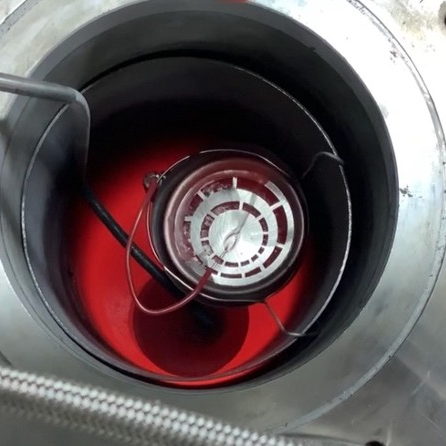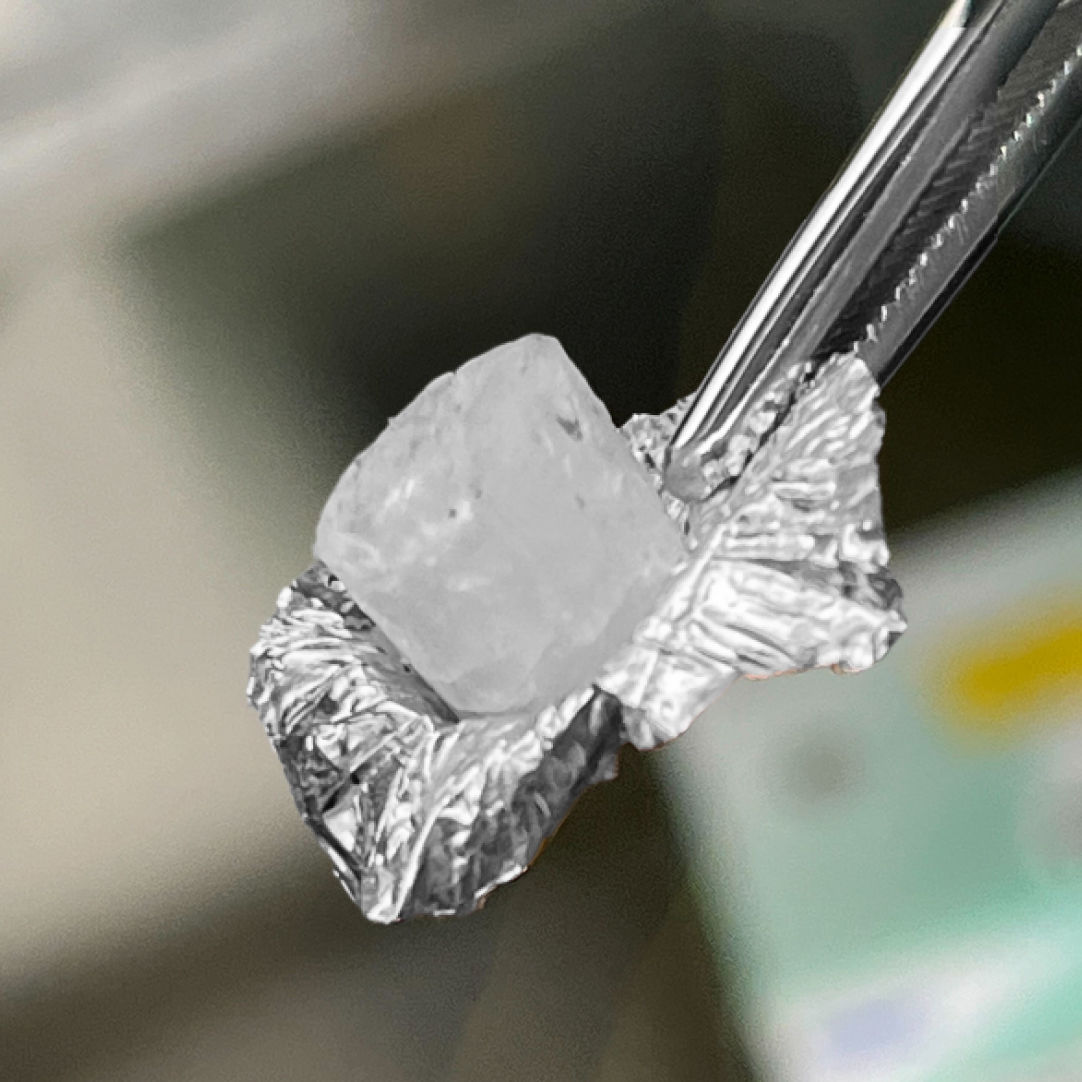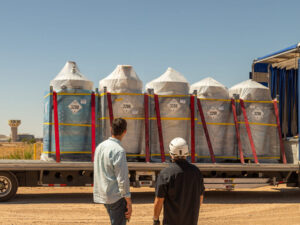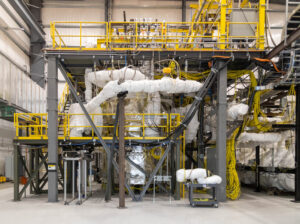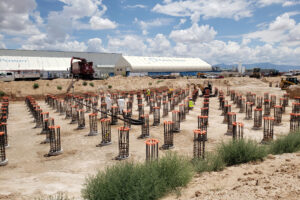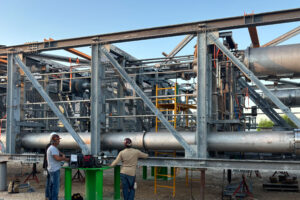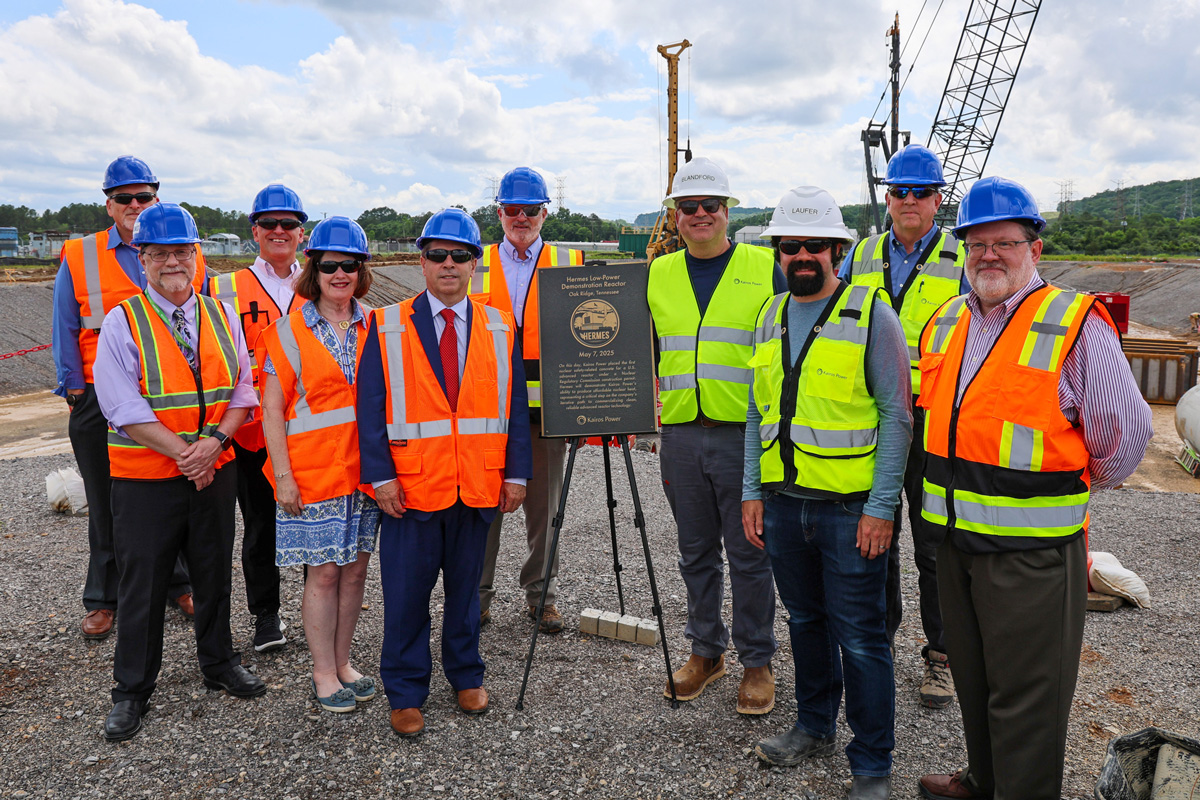Key takeaways:
- Kairos Power used data from the 1960s Molten Salt Reactor Experiment to develop simpler, safer, more cost-effective methods to produce fluoride salt coolant for advanced reactors
- The company has developed a proprietary lithium enrichment process that closes a critical domestic supply chain gap
- A new salt production facility in Albuquerque, N.M. will marry these processes to produce reactor-grade coolant for the Hermes reactor series and future commercial deployments
Kairos Power advanced reactors offer robust, inherent safety with a simplified, compact design. It’s all possible thanks to a molten salt coolant known as “Flibe,” which, combined with TRISO fuel, forms the basis of Kairos Power’s fluoride salt-cooled high-temperature reactor technology, or “KP-FHR” for short.
Flibe is a chemically stable mixture of lithium fluoride and beryllium fluoride first used in the Molten Salt Reactor Experiment (MSRE) at Oak Ridge National Laboratory in the 1960s. MSRE played a foundational role in advancing molten salt reactor research and demonstrating Flibe’s effectiveness as a coolant. However, despite its early promise, Flibe was never used in a commercial reactor.
Kairos Power reactors use a special type of molten fluoride salt coolant called “Flibe,” shown above in liquid and solid forms.
When we set out to commercialize KP-FHR technology, we recognized the inherent challenge in establishing the Flibe supply chain. No supplier produces it in the significant volumes we need. But that didn’t deter us.
The Kairos Power team launched a years-long campaign to develop a scalable process to produce Flibe in-house. In this article, we’ll take you through our journey from lab to pilot to commercial scale and share what’s next as Kairos Power continues the story of Flibe.
Building the Team
The first step in learning to make Flibe was to bring the right people together. Kairos Power formed a dedicated Salt Team in 2018, which dove into the existing process information from the MSRE program decades earlier. While MSRE only produced 2,000 kilograms of salt – a fraction of what would be required for a Kairos Power reactor – the historical data and knowledge gained from the experiment provided a starting point for new research and development.
The Salt Team established a testing program to validate the chemical processes to make Flibe, which included sourcing the requisite materials, particularly beryllium fluoride. We engaged with Materion Corporation, the world’s leading supplier of beryllium products, presenting a new market opportunity for nuclear applications of beryllium fluoride derivatives. In 2020, we signed a Cooperative Development Agreement to collaborate on Flibe production.
In addition to supplying the material we needed, Materion provided guidance on safety protocols and best practices as Kairos Power began working with beryllium. Drawing on their expertise, we commissioned a state-of-the-art Salt Lab at our Alameda, Calif. headquarters in 2020.
Iterating and Simplifying in the Lab
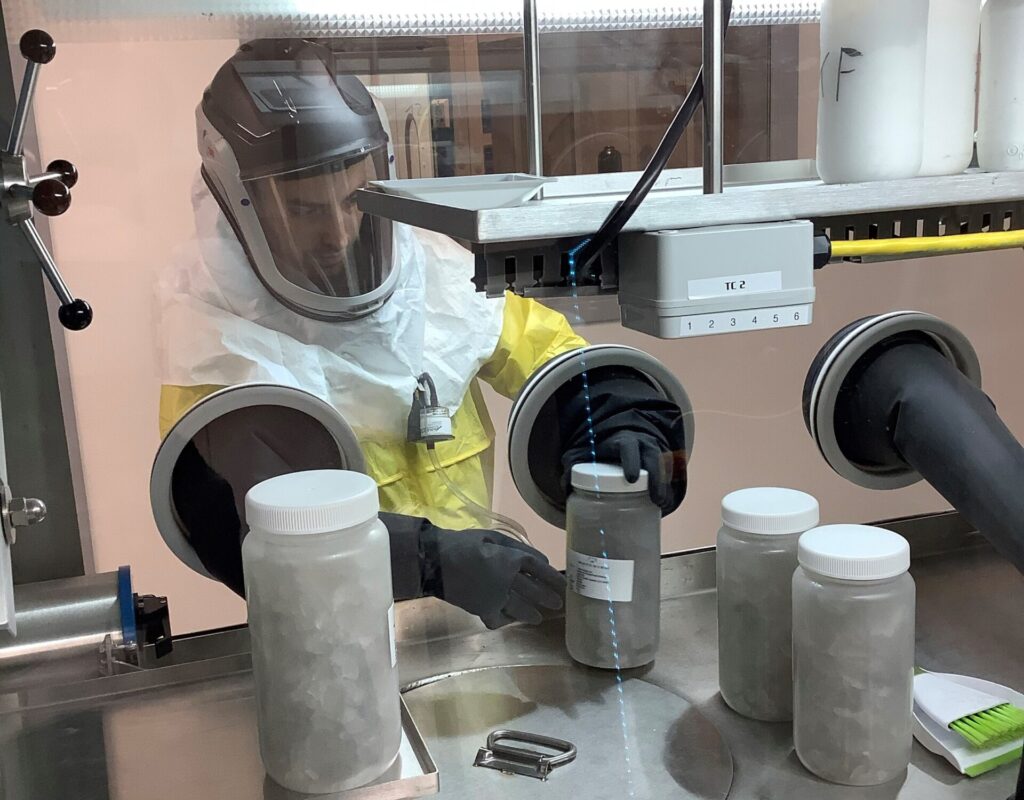
An engineer works with Flibe in the Salt Lab at Kairos Power’s Alameda, Calif. headquarters.
Salt Lab engineers began bench testing the process to make small amounts of unenriched Flibe, producing up to 50 kilograms at a time using MSRE’s paper studies as a blueprint. MSRE provided a baseline that defined the optimal ratio of lithium fluoride to beryllium fluoride and purity requirements to prevent the corrosion of structural materials.
The historic MSRE experiment used extremely high-purity salt to minimize its oxidation potential. This required complex, often hazardous, chemical processing to remove water and oxygen from feed materials. To further protect against corrosion, MSRE engineers built the primary system using a special high-nickel alloy, Hastelloy-N. Our team wondered if those steps were all necessary for Kairos Power’s reactor.
In MSRE, the liquid uranium fuel (and its resulting fission products) were mixed with the salt, making chemistry control a challenge. Kairos Power reactors, on the other hand, use solid TRISO fuel with a robust ceramic coating, which separates the fuel and fission products from the coolant.
Through process trials, we came to understand our unique requirements. We worked backwards, iterating on varying compositions of LiF and BeF2 and evaluating the salt’s corrosivity with different materials. Lab testing demonstrated that we could safely use off-the-shelf 316H stainless steel for salt systems instead of the more expensive Hastelloy-N. And we developed more efficient processes to manage oxidizing impurities, eliminating costly and hazardous purification steps.
Ultimately, the Kairos Power Salt Team arrived at industrially viable specifications for Flibe molten salt, which are less stringent than MSRE’s, but deliver the performance we need without sacrificing corrosion resistance.
With our requirements defined, we worked with Materion to establish specifications for beryllium fluoride feedstock and implement quality controls to keep impurities like graphite within spec. This ensured a consistent output, while helping both companies better understand their supply chains in the process.
Through our lab-based testing campaign, we ultimately simplified the Flibe production process, reduced material costs, and enhanced process safety and reliability. These lessons would prove crucial for the next stage of Flibe production: building our industrial salt synthesis pilot plant.
Making Flibe at Industrial Scale
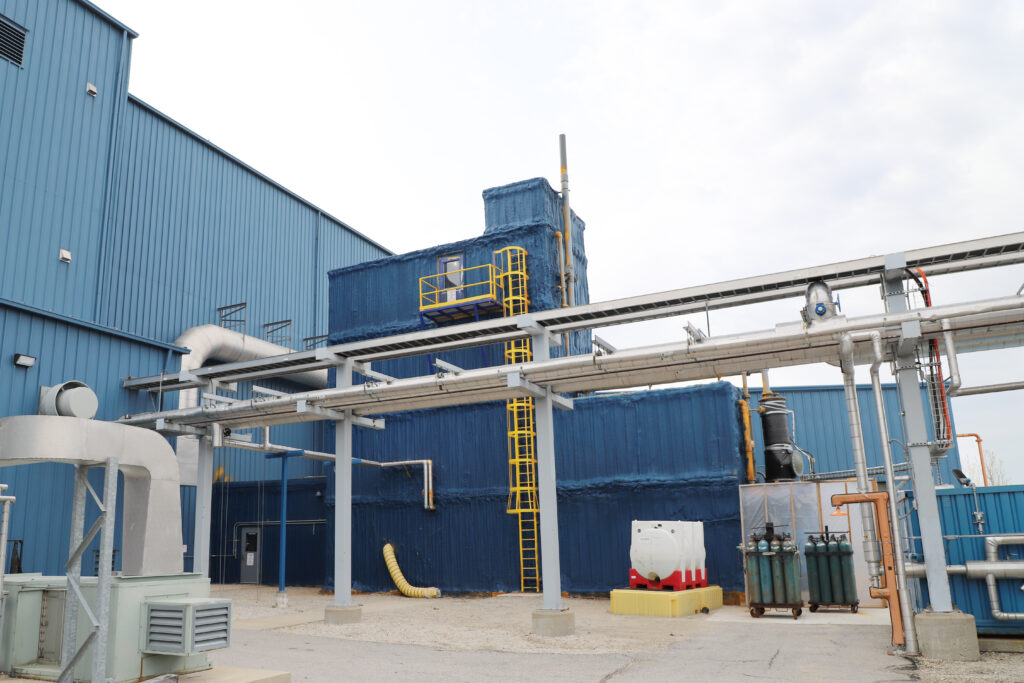
The Molten Salt Purification Plant at Materion’s campus in Elmore, Ohio.
Kairos Power’s Salt Team began designing the Molten Salt Purification Plant (MSPP) early on while Salt Lab operations were still ramping up. As we came to better understand our requirements, we overhauled the design, eliminating some purification steps before taking the concept from the page to construction.
We worked with Materion to build the pilot plant at their campus in Elmore, Ohio, and commissioned it in 2022. MSPP operators began producing Flibe for Kairos Power’s first Engineering Test Unit (ETU 1.0) – a reactor-scale, non-nuclear test built in part to exercise the supply chain and establish Flibe production.
Moving large volumes of salt through MSPP’s multi-stage process introduced many new challenges and learning opportunities. When charging lines repeatedly became plugged with salt, we reduced their thickness and weight to improve maintainability. When molten salt valves had issues with leakage, we replaced them with specially designed freeze valves to enhance performance and reliability.
Flibe production accelerated as we gained operational experience and made ongoing improvements to the plant. The first 2,000-kilogram batch took six months to produce. By the end, we were completing a new batch every 20 days. Within a year, and after considerable learning, we successfully produced 14 metric tons of Flibe in total and loaded 12 metric tons into ETU 1.0, making it the largest molten Flibe system ever built.
A shipment of Flibe arrives at Kairos Power’s Albuquerque testing facility for ETU 1.0, the largest molten Flibe system ever built.
Having demonstrated the ability to produce industrial quantities of unenriched Flibe for non-nuclear systems, it was time for the next challenge: producing enriched Flibe for reactors.
Lithium Enrichment: Solving a U.S. Energy Security Problem
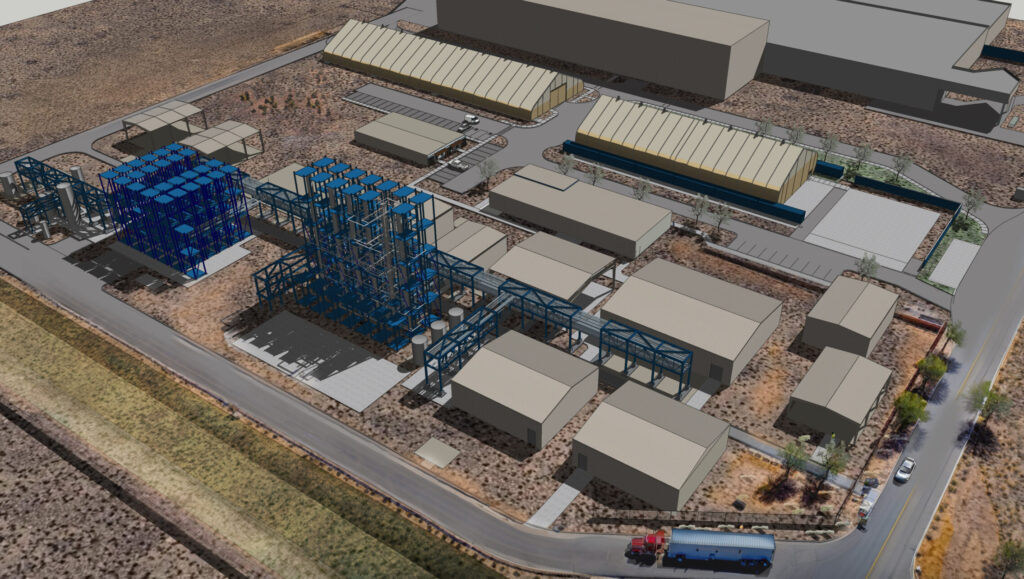
Rendering of the Salt Production Facility at Kairos Power’s Manufacturing Development Campus in Albuquerque, N.M.
Kairos Power reactors require Flibe enriched to >99.99% in the lithium-7 isotope. Natural lithium contains ~92.5% lithium-7 and ~7.5% lithium-6. We must remove that ~7.5% before using the material in a reactor, where lithium-6 atoms would capture neutrons to make tritium – something we aim to minimize.
Kairos Power reactors are not the only ones that require enriched lithium. The U.S. light water reactor fleet uses enriched lithium hydroxide to control cooling water pH. However, there is currently no source of enriched lithium in the U.S. – it is primarily made in China and Russia.
In parallel with our salt synthesis research, we began exploring how to close this domestic supply chain gap. We sought to develop a responsible, sustainable enrichment method that would alleviate the environmental concerns presented by the conventional column exchange (COLEX) process, which uses large amounts of mercury. We were determined to find a better way and to establish production in the U.S.
Working in the lab over several years and many iterations, the Salt Team developed an innovative, proprietary process to chemically isolate lithium-7 that meets the stringent specifications for Kairos Power reactors while honoring our mission to protect the environment. While our current focus is on producing material for the Kairos Power fleet, this new method could have broad applications within the U.S. nuclear industry.
We are now working to scale up our proprietary lithium enrichment capability, building a dedicated Salt Production Facility (SPF) in Albuquerque, N.M., which incorporates lessons learned from our lab-based testing and the Molten Salt Purification Plant.
The new facility will unify all stages of Flibe production: Using isotopic separation to remove lithium-6, turning the purified lithium-7 into lithium fluoride, and combining it with beryllium fluoride to make reactor-grade Flibe.
Making Flibe for Hermes
Kairos Power’s Salt Production Facility will establish enriched Flibe production for the Hermes reactor series in Oak Ridge, Tennessee, and the commercial units that will follow. The larger plant will have increased throughput, improving on the pilot-scale MSPP to remove bottlenecks and maximize production capacity.
Kairos Power broke ground on SPF in October 2024 and has begun fabricating plant equipment off-site that will be installed in the coming months.
Construction of Kairos Power’s Salt Production Facility is underway.
In addition to making the coolant for Kairos Power’s first reactors, SPF will serve a critical mission in proving the processes to make reactor-grade Flibe at a commercial scale. The learning we gain from SPF operations will help us to expand Flibe production and ramp up fleet deployment in the coming decade.
Looking Ahead
Kairos Power’s ongoing journey to establish the Flibe supply chain is central to our clean energy mission and a leading example of our vertical integration strategy in action. With a world-class team, unparalleled expertise, and dedicated production infrastructure, Kairos Power’s ability to make critical materials and components in-house will be fundamental to delivering commercially viable advanced reactor technology for the benefit of energy users everywhere.
Why Flibe?
- High Thermal Capacity: In a KP-FHR reactor, molten Flibe flows through the core to absorb heat generated by fission, then transfers this thermal energy to the steam plant to produce electricity. The salt’s high thermal capacity makes it an excellent heat transfer medium, moving large amounts of heat with a small volume of fluid, allowing the reactor to generate considerable power in a compact size.
- Low-Pressure Operation: With low volatility and a boiling point of 1,430 °C, Flibe remains liquid at high temperatures and near-atmospheric pressure. It does not need to be pressurized like a water-cooled reactor. This eliminates the need for thick-walled, high-pressure reactor components, thereby reducing the cost of construction.
- Inherent Safety: Flibe’s affinity for radionuclides plays an important role in radiological containment, working with TRISO to make KP-FHR inherently safe. In the unlikely event that fission products escape the TRISO fuel’s robust ceramic shell, they will be absorbed in the salt. The functional containment provided by TRISO and Flibe eliminates the need for additional containment structures, shrinking the footprint of safety-related systems and further lowering costs.
